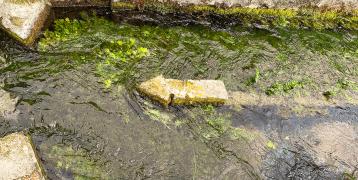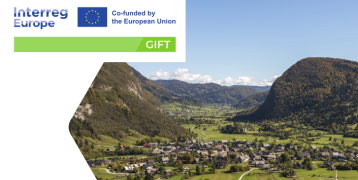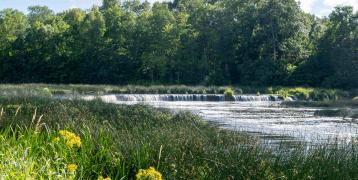Building water resilience: key learnings
On 26 February, the Policy Learning Platform organized a workshop in Murcia, Spain, bringing together around 60 public authorities and Interreg Europe project partners to discuss water resilience in times of floods and droughts.
What was the workshop about?
Interreg Europe community members gathered in Murcia to exchange their experiences with flood and drought prevention, water reuse, nature-based solutions and other initiatives that are building water resilience at a regional level.
For each of these themes, good practices were presented to illustrate relevant approaches and workshop participants shared their own local challenges and experiences. The participants shared key recommendations stemming from the exchanges and learnings they benefited from.
To learn more about this topic, explore the conclusions report our experts have prepared for you.
It contains insights related to a better water resilience as well as inspiring Interreg Europe good practices and policy recommendations.
Featured projects
Featured good practices
Water efficiency and water availability
(Gov4Water project, José Sandoval Moreno, Regional Government of Murcia)
The presentation depicts the water resilient strategies and key priorities for the Mediterranean region. The region emphasises water resilience as critical to addressing scarcity, climate change and desertification. The approach incorporates matching water availability to demand, including using alternative water sources (desalination, water reuse), investing in storage infrastructure and optimising water use across sectors.
(Pedro Simon, Entity of Sanitation and Treatment of Murcia Region)
Despite quite low annual precipitation, more than three million tonnes of agricultural products are grown every year in the Murcia region. This is possible thanks to Spain being the country with the highest water reuse in Europe. Fifteen percent of irrigation water in Murcia comes from reclaimed water. The presentation described the main concerns of citizens and how to build trust in water reuse. It highlighted the need for adequate and sufficient water treatment infrastructure, political will and adequate control and management system.
(DECA project, presenter: Ewa Krolikowska)
Over 57% of the Mazovia region in Poland is highly vulnerable to agricultural drought, while approximately 30% of its rivers, lakes and water reservoirs are at risk of hydrological drought. To mitigate the effects of drought, Mazovia is building small retention reservoirs, developing irrigation-drainage water management systems, restoring wetlands and rivers, reducing water consumption in urban and industrial areas, supporting blue-green infrastructure, using permeable surfaces, and implementing monitoring, forecasting and early warning systems.
Floods and extreme weather events
The following good practices have been presented for better resilience and preparedness for floods and extreme weather events.
(RIWET project, presenter: David Campos)
The presentation provides a comprehensive overview of the Spanish water governance structure and points out some discrepancies and problems that can happen between local authorities and the River Basin Authority. The presentation talked about the recent catastrophic DANA flood, which affected 78 municipalities, including Valencia and resulted in the death of 230 people. The observations from DANA indicated a necessary transformation of the water governance model, including actions such as enhancing the strength of public administrations, improving coordination of sectoral policies, and increasing transparency and coherence between different administrative levels. A need for free from obstacles floodplains and a basin-wide approach to river water management was highlighted.
(ADAPTO project, presenter: Adam Coffey)
The presentation describes the Clonmel Flood Scheme built in Tipperary County Council, Ireland. The Municipality of Clonmel has often been experiencing significant flooding. The town has investigated various options and finally decided to construct a combination of permanent and demountable flood defences. The permanent structure took the form of a 1.2m high reinforced concrete wall, which incorporated receiving arrangements into which a demountable system is installed when required. The solution is combined with a flood warning system based on forecast rainfall and actual river levels. When a predicted level crosses pre-determined thresholds, an alert is issued, and the barrier is erected.
(GIFT project, presenter: Mathias Scholz)
The purpose of the “Lebendige Luppe” project is to counteract the conditions that have led to a lack of water in the floodplain and to restore the function of the regularly flooded areas. This includes revitalising former stream courses, protecting oxbow lakes, and conserving floodplain biodiversity. It is hoped that this work will be a foundation for future, complimentary revitalisation projects and measures which will also promote and further the creation of dynamic water systems, typical of floodplains.
During our study visit we explored three different areas. First stop was the rain garden in San Javier, where water is collected during periods of heavy rain. The raingarden is hidden below the surface, reducing visual impact. The second stop was the retention catchment basin in San Javier, which reduces overflow, improves the wastewater treatment plant (WWTP) management as the water is stored in the reservoir and does not overwhelm the WWTP, and is used for agricultural purposes. At the third stop we explored a storm tank in Torre-Pacheco, where we have seen a pre-tank with autocleaning and a pond that saves water before it enters the WWTP. The aim of the facility was to avoid discharges of the excess flow without treatment.



